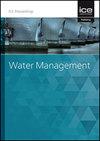Multilayer modelling as a support tool for flood diagnosis and drainage system design
IF 0.9
4区 工程技术
Q3 ENGINEERING, CIVIL
Proceedings of the Institution of Civil Engineers-Water Management
Pub Date : 2023-08-01
DOI:10.1680/jwama.21.00041
引用次数: 1
Abstract
The use of dual-drainage models has increased in recent decades, mostly because of advances in mathematical methods and geographic information system tools. This type of modelling provides precise diagnoses and can be applied to evaluate stormwater infrastructure and diverse drainage alternatives. Minor and major drainage relations in the Dona Eugênia watershed, Brazil, were analysed in this study. Three alternatives simulated the quasi-two-dimensional hydrodynamic model Modcel. The first alternative considered only the terrain surface layer, representing the current situation. In the second alternative, a layer containing a designed storm sewer was introduced. Considering the previous alternatives as a way to diagnose the main minor and major deficiencies, a third alternative was formulated considering previous projects to solve floods in the watershed, incorporating them in the second alternative with functional minor drainage. The results identified the locations of minor drainage gaps, thus helping to direct efforts to the most critical regions, optimise operations and minimise maintenance costs. The results could also be used to evaluate the effects of storm sewer network discharges in major drainage systems, leading to better design of the drainage infrastructure. The major drainage itself can be optimised, once its responsibility in flooding is identified.多层模型作为洪水诊断和排水系统设计的辅助工具
近几十年来,双排水模型的使用有所增加,主要是因为数学方法和地理信息系统工具的进步。这种类型的模型提供了精确的诊断,并可用于评估雨水基础设施和各种排水方案。本研究分析了巴西多纳Eugênia流域的主要和次要排水关系。三种备选方案模拟了准二维水动力模型modelel。第一个备选方案只考虑地形表层,代表当前情况。在第二种方案中,引入了一个包含设计的雨水下水道的层。考虑到之前的备选方案是诊断主要次要和主要缺陷的一种方法,考虑到之前解决流域洪水的项目,制定了第三种备选方案,将它们纳入具有功能性次要排水的第二种备选方案。结果确定了次要排水间隙的位置,从而有助于将工作引向最关键的区域,优化操作并最大限度地降低维护成本。研究结果还可用于评估主要排水系统中暴雨下水道网络排放的影响,从而更好地设计排水基础设施。一旦确定了主要排水系统在洪水中的责任,就可以对其进行优化。
本文章由计算机程序翻译,如有差异,请以英文原文为准。
求助全文
约1分钟内获得全文
求助全文
来源期刊
CiteScore
2.10
自引率
0.00%
发文量
28
审稿时长
6-12 weeks
期刊介绍:
Water Management publishes papers on all aspects of water treatment, water supply, river, wetland and catchment management, inland waterways and urban regeneration.
Topics covered: applied fluid dynamics and water (including supply, treatment and sewerage) and river engineering; together with the increasingly important fields of wetland and catchment management, groundwater and contaminated land, waterfront development and urban regeneration. The scope also covers hydroinformatics tools, risk and uncertainty methods, as well as environmental, social and economic issues relating to sustainable development.

 求助内容:
求助内容: 应助结果提醒方式:
应助结果提醒方式:


